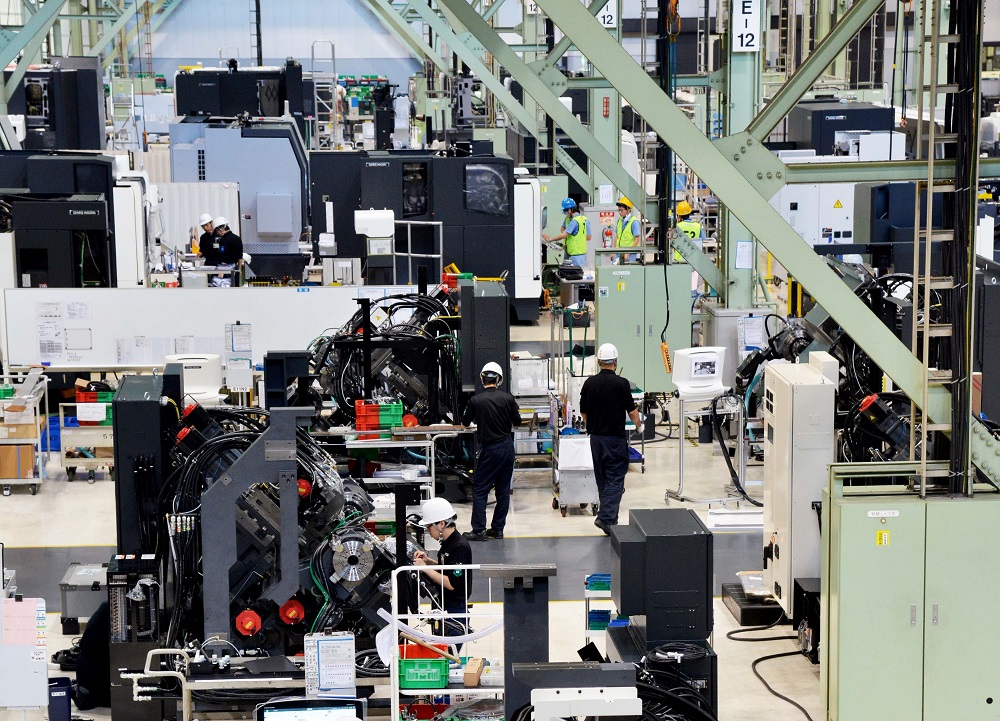
- News
- Basics
- Products
- JP Job shop
- Exhibition
- Interview
- Statistic
- PR
- Download
- Special contents
Statistic
March 22, 2024

The Japan Machine Tool Builders’ Association (JMTBA) released the summary of Japanese machine tool orders for 2023, showing a 15.5% year-on-year (YoY) decline to 1,486 billion yen, the first decline in three years. The total amount of orders fell below 1,500 billion yen for the first time in three years due to the settlement of pent-up demand, semiconductor-related demand, and automotive-related demand that had driven the recovery from the pandemic, as well as a slowdown in China due to the real estate recession, but it was still the seventh largest order amount ever recorded.
In this context, orders for CNC machine tools decreased by 15.3% to 1.4 trillion yen, and the ratio of CNC machine tools to total orders was 98.4% (+0.2 pt YoY), exceeding 98% for the eighth consecutive year. Foreign demand accounted for 67.9% of total orders, up 2.2 points from the previous year.
Domestic demand declined for the first time in three years, falling 21.0% YoY to 476.8 billion yen, the first time in three years that domestic demand fell below 500 billion yen.
A firm but gradual downward trend was observed throughout the year as post-pandemic pent-up demand, which drove orders until the second half of 2022, capacity expansion investment driven by parts shortages, and semiconductor-related demand gradually weakened. In the second half of 2023, there were many months in which single-month orders fell below 40 billion yen.
By industry, 10 of the 11 industries showed YoY declines. Of the four major industries, all except “Aircraft, Shipbuilding & Transportation Machinery (+7.0 YoY to JPY 20.2 billion) ” showed declines of 10% or more YoY. Orders for “Electrical & Precision” (-33.3% YoY to JPY 55.7 billion), which receives many orders from semiconductor-related industries, and “Automotive(-25.3% YoY to JPY 100.6 billion)”, where investment in both internal combustion engines and electric vehicles was weak, showed particularly large declines. Among other industries, “Trading Companies/Agents (-32.8% YoY to JPY 4.6 billion)” and “Metal Products (-27.2% YoY to JPY 36.8 billion)” also saw declines of over 20%.
Foreign demand decreased 12.7% YoY to 1,009.7 billion yen, the third consecutive year above 1 trillion yen and the sixth largest order volume ever, although it was the first decrease in three years. Orders from Asia declined, particularly in China, while orders from Europe and North America remained solid despite strong inflation concerns and the yen’s depreciation trend, with total foreign orders averaging 84.1 billion yen per month.
By region, orders from Asia declined for the first time in three years, falling 23.2% to 427.6 billion yen, the first time in three years that the value of orders fell below 500 billion yen, but still in the 400 billion yen range.
Of this total, orders in East Asia declined 28.3% YoY to 319.8 billion yen, with orders from South Korea (-24.0% YoY to JPY 25.0 billion), Taiwan (-43.5% YoY to JPY 20.3 billion) and China (-27.3% YoY to JPY 74.0 billion) each declining more than 20% YoY. In China in particular, capital investment was sluggish due to a sharp decline in electronic manufacturing services (EMS) and electric vehicle-related investment, which had driven orders in the previous year, as well as economic instability caused by the bursting of the real estate bubble.
In other Asian countries and regions, while many countries and regions showed YoY declines, India was the only one that performed well and posted an increase, resulting in a 2.8% YoY decline to 107.8 billion yen, the first decline in three years, but the second consecutive year that it exceeded 100 billion yen. In India (+26.5% YoY to 51.1 billion yen), orders were strong, especially in the automotive sector, and orders for semiconductors and EMS-related products also increased, with the General Machinery and Electrical & Precision industries both reaching record highs, and the total for India also exceeding 50 billion yen for the first time, setting a new record.
Orders from Europe increased for the third consecutive year, rising 1.1% year on year to 233.5 billion yen, the fourth highest on record, despite concerns about the impact of energy issues and high interest rates, as well as geopolitical risks such as Russia’s invasion of Ukraine, which began in February 2022, and the Gaza Strip, where fighting between the Israeli military and Hamas has been ongoing.
By country, Germany (+6.3% YoY to JPY 56.5 billion) and “Other EU” (+2.7% YoY to JPY 38.4 billion) within the EU (-3.9% YoY to JPY 169.9 billion) recorded high levels of orders. In “Other Western Europe,” Turkey (+38.9% YoY to JPY 22.7 billion) and Switzerland (+27.9% YoY to JPY 14.8 billion) each recorded the highest values since the statistical category began in 2015 for the second year in a row.
Orders from North America fell 6.9% YoY to 320.6 billion yen, the first decline in three years, but remained above 300 billion yen for the second consecutive year, the third highest on record. In the United States (-9.6% YoY to JPY 282.0 billion), as in Japan, the recovery in the automotive sector was somewhat delayed and job shop activity slowed slightly due to high interest rates; on the other hand, orders remained strong, particularly in the medical, energy and aerospace sectors, and were the third highest on record. Canada (+15.3% YoY to JPY 19.9 billion) posted its third consecutive year of growth and set a new record for the second year in a row. Mexico (+21.9% YoY to JPY 18.7 billion) recorded its third consecutive year of growth.
JMTBA News Release:https://www.jmtba.or.jp/english/wp-content/uploads/JMTBA-NOTES-2024-02.pdf
February 16, 2024
December 29, 2023
September 1, 2023
September 25, 2025